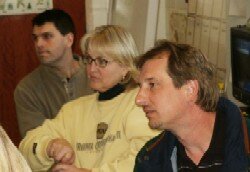
 |
|||
 |
|||
 |
|||
 |
|||
 |
|||
 |
|||
 |
|||
 |
|||
 |
|||
DALEVILLE, VA - This year, scores of teachers in Botetourt County will get to do something most teachers never get to do. They'll spend seven intense days outside the classroom learning state-of-the-art teaching strategies and using technology tools to reach every child, every day.
 |
| Troutville Elementary teachers Trevor Ruble, Frankie Doyle and Gerald Calvert at a QTLT session. Says Calvert, right, "We've been exposed to so much that I never even thought about." |
Botetourt school leaders have created The Botetourt Center for Quality Teaching and Learning. The ambitious professional development initiative expands teachers' capacity to meet the educational needs of every student and challenges of No Child Left Behind legislation. Botetourt administrators say the program will take the system's teachers to the next level of classroom excellence. Teachers who've participated say they're already benefiting.
"I learned a lot, and I was introduced to so much that is made me sort of excited to look and see what else I could do," says Troutville Elementary teacher Frankie Doyle. "I got so many ideas. I had just felt stumped as to how to use technology. It's fun to be exposed to all these neat ideas."
The Quality Teaching and Learning initiative (QTL™) focuses on blending research-based educational theory with the use of technology. The result can be a profoundly different atmosphere in the classroom, with children more actively engaged in the process of learning.
"Schools today have to find ways to make sure every child succeeds," says Dave Boliek, CEO of ExplorNet's Centers for Quality Teaching & Learning™. Botetourt Schools' partner in the program. "Teachers can't rely on the old 'stand-and-deliver' approach anymore. Students come to the classroom with different learning styles and multiple intelligences. QTL™ models proven instructional practices that help teachers meet the needs of every child."
 |
| Heather Ponton of Greenfield Elementary takes on a grave assignment during a QTL field study. |
During the school year, small school-based teams of teachers attend day-long sessions at the Botetourt Center, located at the Greenfield Education and Training Center. The first elementary school teams have just wrapped up their initial training. Botetourt County technology integration specialist Mike Scott says so far, he's very pleased with what they've learned.
"I've been real impressed with the thought that's gone into developing a curriculum that gently leads teachers to take on projects that require skills that they may not have acquired, but do acquire during the course of the project," Scott says. He notes that the assignments and projects in the QTL™ Cycles get more sophisticated as the days go by, and he believes that's one reason teachers are benefiting. "This gradual escalation of skills really mimics a brain-based model that works very well," he says. "It's very effective."
Scott says the next challenge will be providing support for teachers who emerge from the program with great inspiration and plenty of ideas, but run into problems with technology. Teachers say the program has been a springboard to trying new ways to use technology. Participants are already putting concepts to use, trying innovative classroom projects that combine technology skills with core academic content.
Read Mountain Middle School teacher Joyce Mandeville raves about having students create 'trading cards' about historic figures or geographic locations. "It can be used for science or math or English or history. Letting students generate their own study guides kind of gives them ownership of the material. It takes the burden off of us but it also makes them work and manipulate the material so that they're more comfortable and confident when they sit down to take a test."
Troutville Elementary's Trevor Ruble also liked the activities that use technology but focus on academic content. "The thing I find most exciting about it is that every student regardless of their ability can have the same objective and complete it, but the technology tool allows you to differentiate it (for different students)."
Statements like that are encouraging to Mike Scott. "They're very good teachers - highly qualified - but you still need someone to help you figure out how to get past the barriers and use these (tools) effectively."
In the end, it's not the technology but the collaboration with other teachers that may have the most lasting impact. With thin resources for helping teachers who encounter technology problems, Scott worries about supporting scores of teachers trying new ideas. But the teachers themselves say collaborating and capitalizing on each others' strengths will be a big part of the answer.
"What I've found most valuable is working as a group, sharing ideas, working as a team," says Doris Lowe of Eagle Rock Elementary. "We usually just don't have the time that it takes to sit down and plan and learn what valuable assets each of us has. So this has been very valuable."
Back to Top
Please send questions or comments about this site to the QTL™